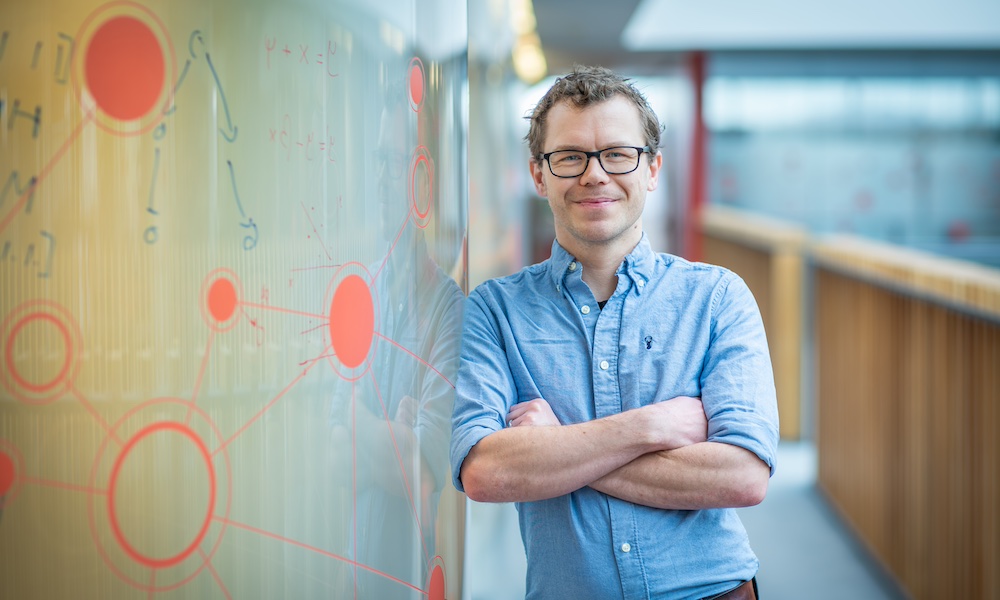
Welcome: Kyle Morris
Kyle Morris joins EMBL-EBI as Electron Microscopy Data Bank (EMDB) Team Leader

Electron microscopy has revolutionised our understanding of the microscopic world, providing new insights into the structures and functions of macromolecules and cellular structures. Kyle Morris joins EMBL’s European Bioinformatics Institute (EMBL-EBI) as the new Team Leader for the Electron Microscopy Data Bank (EMDB). With a background in cryogenic electron microscopy (cryoEM) theory and methodology, Morris is helping drive innovations in data archiving, accessibility, and analysis at EMDB, bridging the gap between complex electron microscopy data and the scientific community’s needs.
Find out more about how Morris aims to tackle the challenges of rapidly evolving electron microscopy techniques while supporting his team’s growth and professional development in this dynamic environment.
Tell us about your professional background
Throughout my research career I’ve been deeply involved in structural biology and electron microscopy. My journey with electron microscopes began during my PhD at the University of Sussex in 2008. As a postdoctoral researcher at the University of Warwick, in 2013, I was also able to use cryoEM for structural biology. This path eventually took me to the University of California, Berkeley, in 2016 where I solved the structures of macromolecules that shed light into their behaviour during viral infection. I am passionate about scientific discovery and biology, but I have been equally passionate about scientific programming to solve unique image processing challenges and creating workflows for myself and others to use in their research.
After returning to the UK in 2018, I became a staff scientist at the MRC Laboratory of Medical Sciences (LMS) in London. Here I helped establish and embed cryoEM and volumeEM imaging techniques at the institute. Later, in 2021, I moved onto the UK national electron microscopy facility at the Diamond Light Source. As the electron Bio-Imaging Centre (eBIC) training coordinator, I was heavily involved in enhancing facility productivity by developing user training programmes. At the same time, I worked with a vibrant campus community to develop systems for metadata capture from the instruments. This project is ongoing but deeply connected to part of EMDB’s future.
What does your role at EMBL-EBI entail?
Currently, I’m team leader for the EMDB at EMBL-EBI. Most importantly, I support the team that maintains the archive that serves our scientific community. This includes people management, oversight of day-to-day operations, and setting long-term goals that align with the evolving needs of fields that use electron microscopy and cryoEM.
The EMDB is crucial in structural biology; we host the processed 3D volumes and tomograms primarily obtained from cryoEM experiments and make these data openly available. In general, once cryoEM raw data has been analysed and processed, a 3D volume – or map – is produced of the object that has been imaged. These 3D volumes are what is interpreted to produce atomic models of macromolecules and discover the mechanics of those biological machines. Our service is essential for the scientific community to assess and look deeper into scientific conclusions drawn from those atomic models.
CryoEM can also capture information on the movements of molecules and cellular structures. Beyond static snapshots, the EMDB is uniquely positioned to expose these perspectives to archive users. Together with our colleagues at the Electron Microscopy Public Image Archive (EMPIAR) who archive cryoEM raw data, the 3D volumes with us at the EMDB, and the atomic models at the PDBe, I believe we can provide rich dataset interconnectivity that in the future can train models – AI or otherwise – to help further our understanding of complex biological structures and processes.
What motivated you to work at EMBL-EBI?
Open access data is so clearly a positive driver in structural biology, and I support building capability in this area 100%. That’s a core part of the EMBL-EBI and EMDB’s mission. I find it fundamentally crucial to make data from experiments open-access to facilitate accountability in scientific research but also to allow data reuse beyond the original research itself. I’m also particularly interested in what we can learn from sharing knowledge and analysing data across the multiple services EMBL-EBI provides – something we’re really well positioned to do here.
What are some challenges in your new job?
Our scientific community is mature, yet the field has seen rapid growth and innovation, especially in the last decade. The challenge lies in balancing responding to the pace of growth while maintaining stable, reliable services. It’s about deciding which scientific advancements to incorporate sensibly without overwhelming our services. It’s both exciting and challenging to navigate this dynamic environment.
What is your approach as a manager?
This is my first formal appointment as a team leader, so I’m actively learning and growing in my management approach. Whether they know it or not, my team has actually been great in supporting me in this. Something I’m enjoying is spotting and prompting opportunities for team work. I hope to help the team in mission-critical project delivery but also realise those projects on the horizon. My approach is to respect and support individual trajectories within my team members. This includes supporting them in current projects and career aspirations. I aim to provide them with autonomy where they need it and guidance where necessary. I believe in listening, learning, and being respectful of their needs.
What is one thing we couldn’t find out about you from an online search?
I am a husband to my wife and a father to two girls which represents my largest investment of time, but something not widely known is my passion for making things. I enjoy woodwork, but I also enjoy crafting and creating cocktails. These might seem like contrasting hobbies, but they both stem from my interest in learning and using tools and techniques to create. The woodworking benefits my family and home, while cocktail making is a fun outlet for my creativity. One of my favourite cocktails is a Negroni. I like that you can easily change the base spirit, which dramatically alters the flavour profile while maintaining the essence of a really great drink. There’s a lot to explore.


